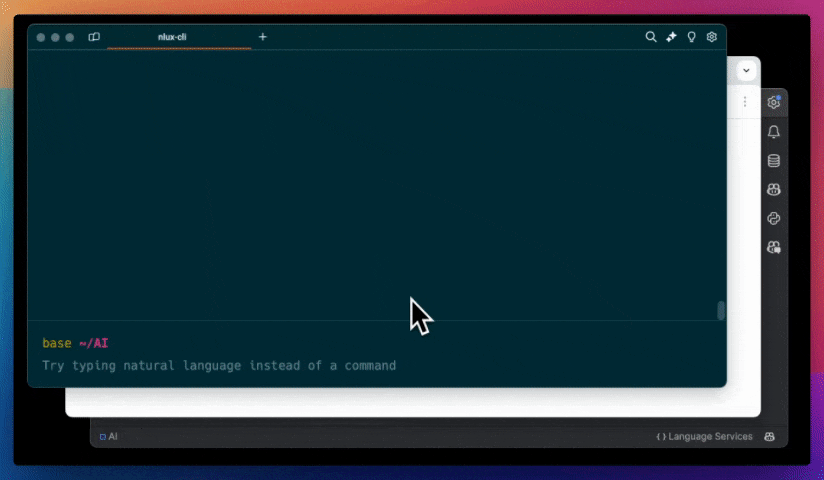
nlux
The 𝗣𝗼𝘄𝗲𝗿𝗳𝘂𝗹 Conversational AI JavaScript Library 💬 — UI for any LLM, supporting LangChain / HuggingFace / Vercel AI, and more 🧡 React, Next.js, and plain JavaScript ⭐️
Stars: 963
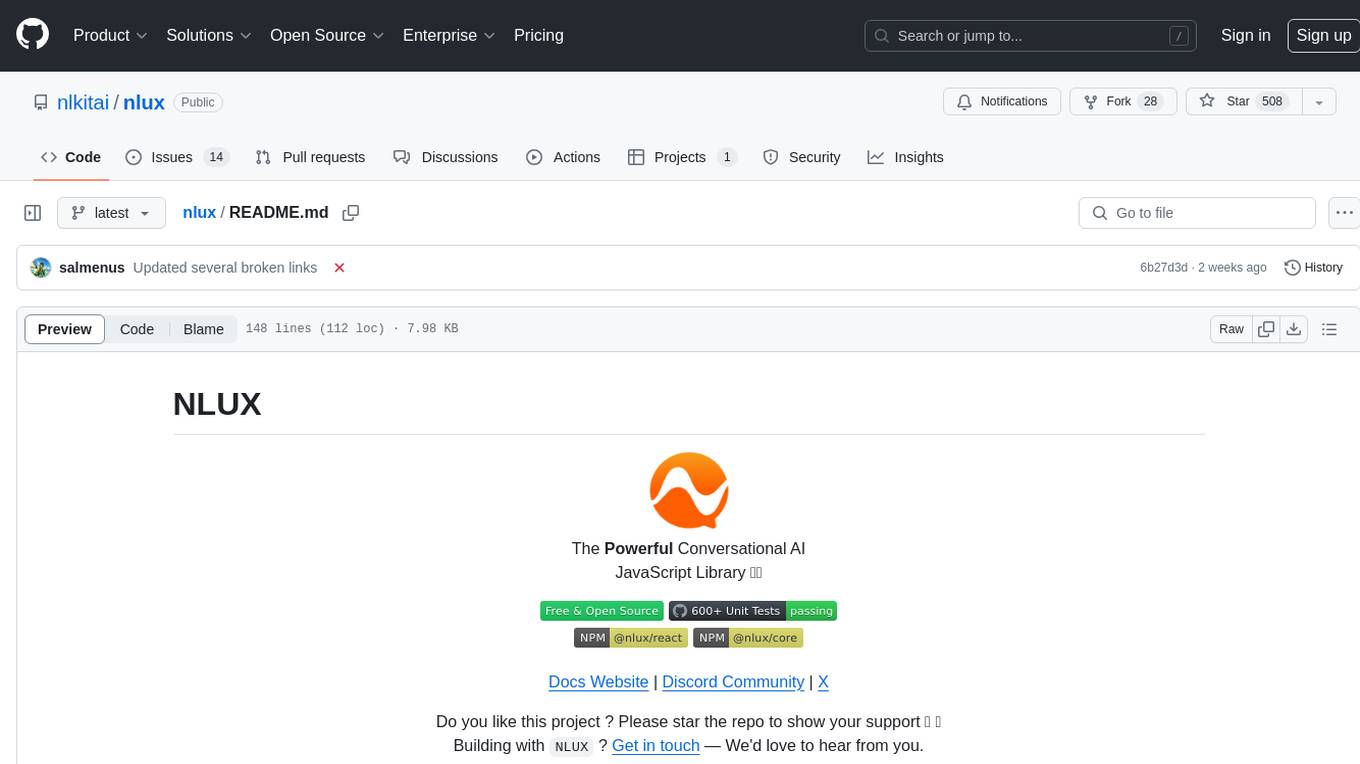
NLUX is an open-source JavaScript and React JS library that simplifies the integration of powerful large language models (LLMs) like ChatGPT into web apps or websites. With just a few lines of code, users can add conversational AI capabilities and interact with their favorite LLM. The library offers features such as building AI chat interfaces in minutes, React components and hooks for easy integration, LLM adapters for various APIs, customizable assistant and user personas, streaming LLM output, custom renderers, high customizability, and zero dependencies. NLUX is designed with principles of intuitiveness, performance, accessibility, and developer experience in mind. The mission of NLUX is to enable developers to build outstanding LLM front-ends and applications with a focus on performance and usability.
README:
The Powerful Conversational AI
JavaScript Library ✨💬
Docs Website | Discord Community | X
Do you like this project ? Please star the repo to show your support 🌟 🧡
Building with NLUX ? Get in touch — We'd love to hear from you.
NLUX is React and JavaScript open-source library for building conversational AI interfaces. It makes it super simple
to build web applications powered by Large Language Models (LLMs). With just a few lines of code, you can add
conversational AI capabilities and interact with your favorite AI models.
Use nlux-cli to quickly spin up a new Next.js, React, or Vanilla TypeScript project with NLUX integrated.
Get started with NLUX and your favorite web framework under a minute:
# Next.js 🔼 with NLUX
npx nlux-cli create next my-next-app# React ⚛️ , Vite, with NLUX
npx nlux-cli create react my-react-app# Or, vanilla TypeScript 🟨 , Vite, with NLUX
npx nlux-cli create vanilla my-vanilla-app-
The docs website is available at:
docs.nlkit.com/nlux -
Several Get Started Guides are available, including for:
Next.js and Vercel AI — LangChain LangServe — React with Node.js Backend
- Build AI Chat Interfaces In Minutes ― High quality conversational AI interfaces with just a few lines of code.
-
React Components & Hooks ―
<AiChat />for UI anduseChatAdapterhook for easy integration. - Next.js & Vercel AI ― Out-of-the-box support, demos, and examples for Next.js and Vercel AI.
- React Server Components (RSC) and Generative UI 🔥 ― With Next.js or any RSC compatible framework.
-
LLM Adapters ― For
ChatGPT―LangChain🦜LangServeAPIs ―Hugging Face🤗 Inference. - A flexible interface to Create Your Own Adapter 🎯 for any LLM ― with support for stream or batch modes.
- Assistant and User Personas ― Customize participant personas with names, images, and descriptions.
- Highly Customizable ― Tune almost every UI aspect through theming, layout options, and more.
- Zero Dependency ― Lightweight codebase ― Core with zero dependency and no external UI libraries.
This GitHub repository contains the source code for the NLUX library.
It is a monorepo that contains code for following NPM packages:
⚛️ React JS Packages:
-
@nlux/react― React JS components forNLUX. -
@nlux/langchain-react― React hooks and adapter for APIs created using LangChain's LangServe library. -
@nlux/openai-react― React hooks for the OpenAI API, for testing and development. -
@nlux/hf-react― React hooks and pre-processors for the Hugging Face Inference API -
@nlux/nlbridge-react― Integration withnlbridge, the Express.js LLM middleware by the NLUX team.
🟨 Vanilla JS Packages:
-
@nlux/core― The core Vanilla JS library to use with any web framework. -
@nlux/langchain― Adapter for APIs created using LangChain's LangServe library. -
@nlux/openai― Adapter for the OpenAI API, for testing and development. -
@nlux/hf― Adapter and pre-processors for the Hugging Face Inference API. -
@nlux/nlbridge― Integration withnlbridge, the Express.js LLM middleware by the NLUX team.
🎁 Themes & Extensions:
-
@nlux/themes― The defaultLunatheme and CSS styles. -
@nlux/markdown― Markdown stream parser to render markdown as it's being generated. -
@nlux/highlighter― Syntax highlighter based on Highlight.js.
Please visit each package's NPM page for information on how to use it.
The following design principles guide the development of NLUX:
-
Intuitive ― Interactions enabled by
NLUXshould be intuitive. Usage should unfold naturally without obstacles or friction. No teaching or thinking should be required to use UI built withNLUX. -
Performant ―
NLUXshould be as fast as possible. Fast to load, fast to render and update, fast to respond to user input. To achieve that, we should avoid unnecessary work, optimize for performance, minimize bundle size, and not depend on external libraries. -
Accessible ― UI built with
NLUXshould be accessible to everyone. It should be usable by people with disabilities, on various devices, in various environments, and using various input methods (keyboard, touch, voice). -
DX ―
NLUXrecognizes developers as first-class citizens. The library should enable an optimal DX (developer experience). It should be effortless to use, easy to understand, and simple to extend. Stellar documentation should be provided. The feature roadmap should evolve aligning to developer needs voiced.
Our mission is to enable developers to build outstanding LLM front-ends and applications, cross platforms, with a focus on performance and usability.
-
Star The Repo 🌟 ― If you like
NLUX, please star the repo to show your support.
Your support is what keeps this open-source project going 🧡 - GitHub Discussions ― Ask questions, report issues, and share your ideas with the community.
- Discord Community ― Join our Discord server to chat with the community and get support.
- docs.nlkit.com/nlux Developer Website ― Examples, learning resources, and API reference.
NLUX is licensed under Mozilla Public License Version 2.0 with restriction to use as
part of a training dataset to develop or improve AI models, or as an input for code
translation tools.
Paragraphs (3.6) and (3.7) were added to the original MPL 2.0 license.
The full license text can be found in the LICENSE file.
In a nutshell:
- You can use
NLUXin your personal projects. - You can use
NLUXin your commercial projects. - You can modify
NLUXand publish your changes under the same license. - You cannot use
NLUX's source code as dataset to train AI models, nor with code translation tools.
Wondering what it means to use software licensed under MPL 2.0? Learn more
on MPL 2.0 FAQ.
Please read the full license text in the LICENSE file for details.
This open-source project fits under the umbrella of NLKit, a suite of tools and libraries for
building conversational AI applications. NLUX is the first project in the NLKit suite, with more to come.
The project is being led by Salmen Hichri, a senior software engineer with over a decade of experience building user interfaces and developer tools at companies like Amazon and Goldman Sachs, and contributions to open-source projects.
For Tasks:
Click tags to check more tools for each tasksFor Jobs:
Alternative AI tools for nlux
Similar Open Source Tools

nlux
NLUX is an open-source JavaScript and React JS library that simplifies the integration of powerful large language models (LLMs) like ChatGPT into web apps or websites. With just a few lines of code, users can add conversational AI capabilities and interact with their favorite LLM. The library offers features such as building AI chat interfaces in minutes, React components and hooks for easy integration, LLM adapters for various APIs, customizable assistant and user personas, streaming LLM output, custom renderers, high customizability, and zero dependencies. NLUX is designed with principles of intuitiveness, performance, accessibility, and developer experience in mind. The mission of NLUX is to enable developers to build outstanding LLM front-ends and applications with a focus on performance and usability.

nlux
nlux is an open-source Javascript and React JS library that makes it super simple to integrate powerful large language models (LLMs) like ChatGPT into your web app or website. With just a few lines of code, you can add conversational AI capabilities and interact with your favourite LLM.
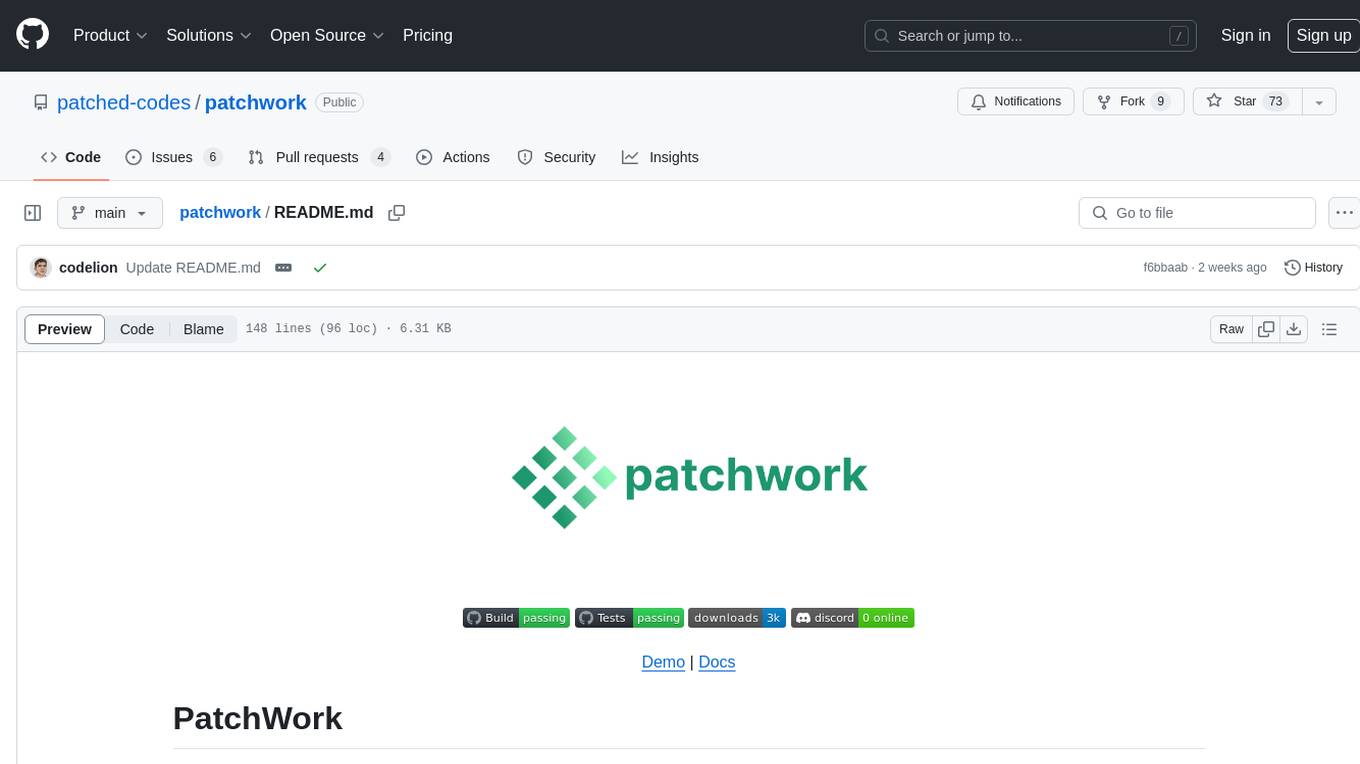
patchwork
PatchWork is an open-source framework designed for automating development tasks using large language models. It enables users to automate workflows such as PR reviews, bug fixing, security patching, and more through a self-hosted CLI agent and preferred LLMs. The framework consists of reusable atomic actions called Steps, customizable LLM prompts known as Prompt Templates, and LLM-assisted automations called Patchflows. Users can run Patchflows locally in their CLI/IDE or as part of CI/CD pipelines. PatchWork offers predefined patchflows like AutoFix, PRReview, GenerateREADME, DependencyUpgrade, and ResolveIssue, with the flexibility to create custom patchflows. Prompt templates are used to pass queries to LLMs and can be customized. Contributions to new patchflows, steps, and the core framework are encouraged, with chat assistants available to aid in the process. The roadmap includes expanding the patchflow library, introducing a debugger and validation module, supporting large-scale code embeddings, parallelization, fine-tuned models, and an open-source GUI. PatchWork is licensed under AGPL-3.0 terms, while custom patchflows and steps can be shared using the Apache-2.0 licensed patchwork template repository.
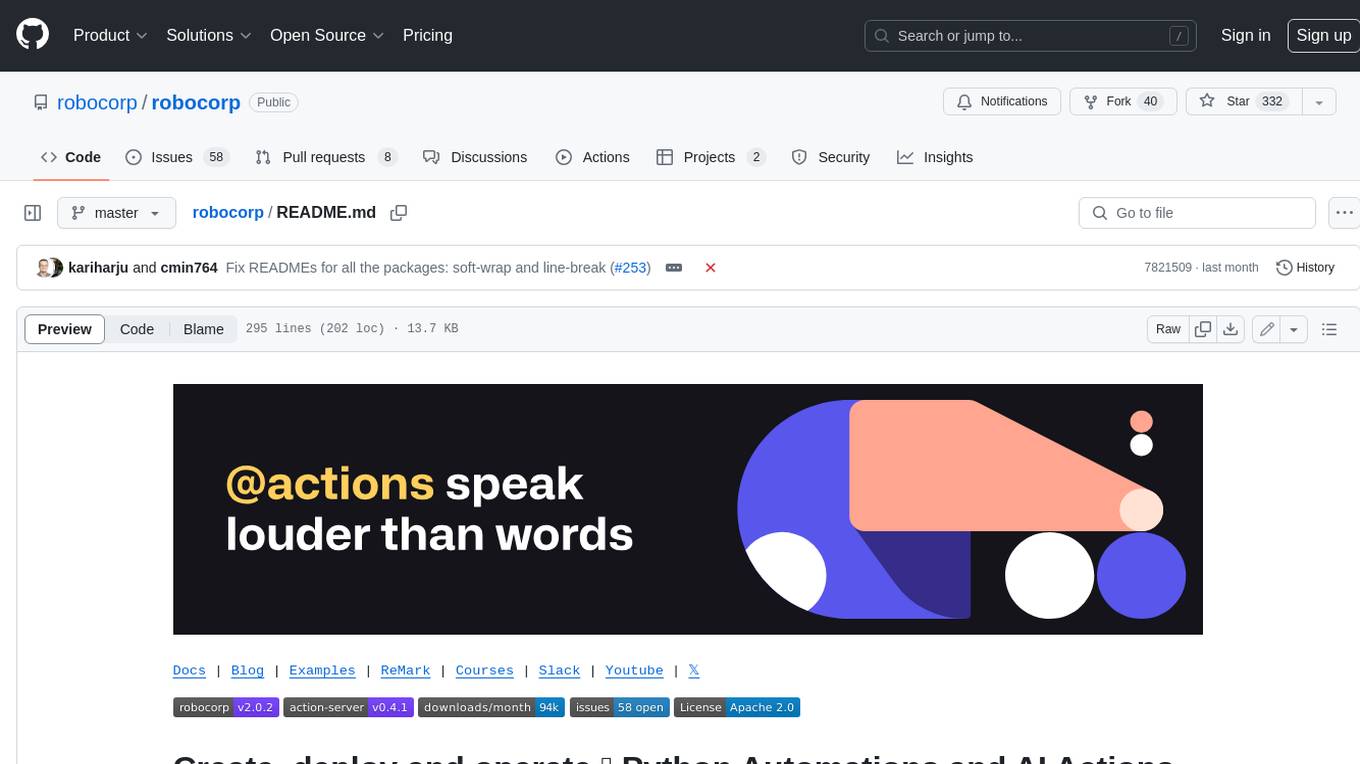
robocorp
Robocorp is a platform that allows users to create, deploy, and operate Python automations and AI actions. It provides an easy way to extend the capabilities of AI agents, assistants, and copilots with custom actions written in Python. Users can create and deploy tools, skills, loaders, and plugins that securely connect any AI Assistant platform to their data and applications. The Robocorp Action Server makes Python scripts compatible with ChatGPT and LangChain by automatically creating and exposing an API based on function declaration, type hints, and docstrings. It simplifies the process of developing and deploying AI actions, enabling users to interact with AI frameworks effortlessly.
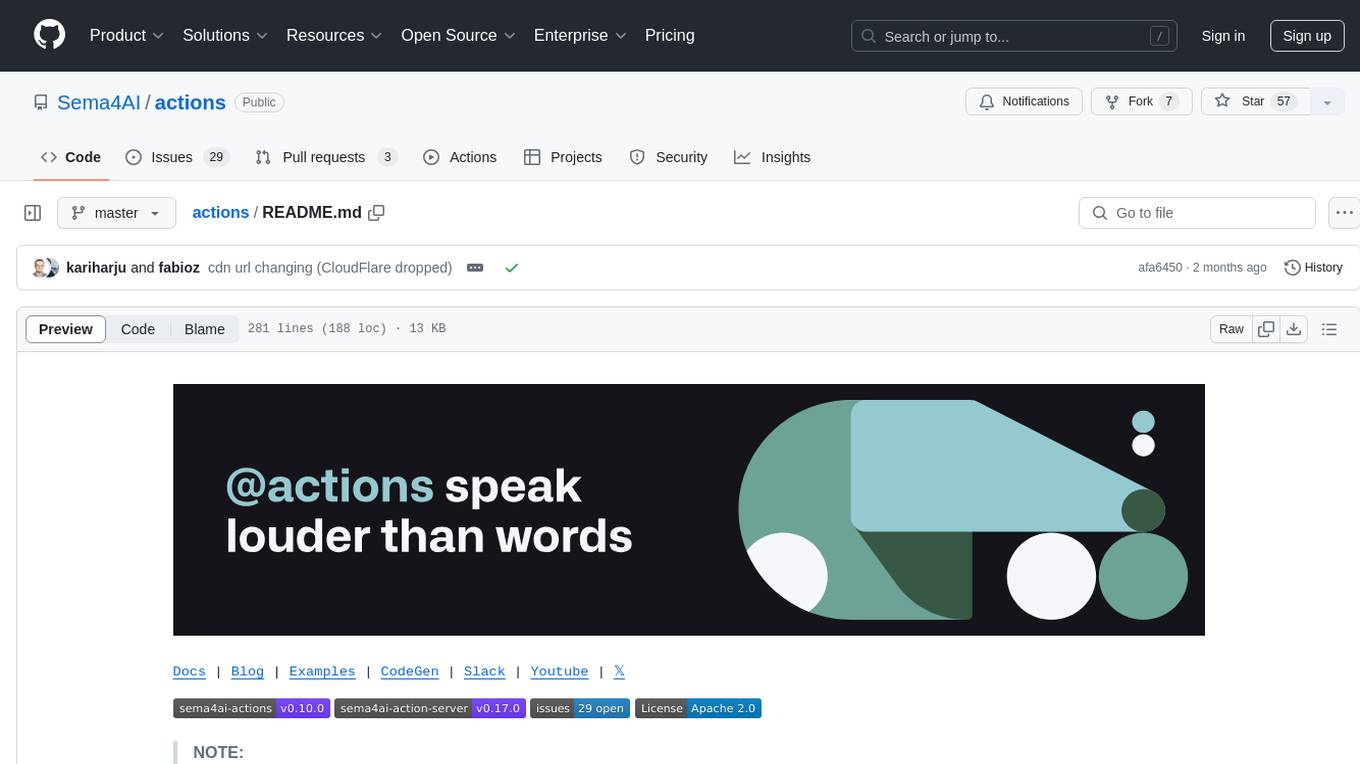
actions
Sema4.ai Action Server is a tool that allows users to build semantic actions in Python to connect AI agents with real-world applications. It enables users to create custom actions, skills, loaders, and plugins that securely connect any AI Assistant platform to data and applications. The tool automatically creates and exposes an API based on function declaration, type hints, and docstrings by adding '@action' to Python scripts. It provides an end-to-end stack supporting various connections between AI and user's apps and data, offering ease of use, security, and scalability.

orama-core
OramaCore is a database designed for AI projects, answer engines, copilots, and search functionalities. It offers features such as a full-text search engine, vector database, LLM interface, and various utilities. The tool is currently under active development and not recommended for production use due to potential API changes. OramaCore aims to provide a comprehensive solution for managing data and enabling advanced AI capabilities in projects.
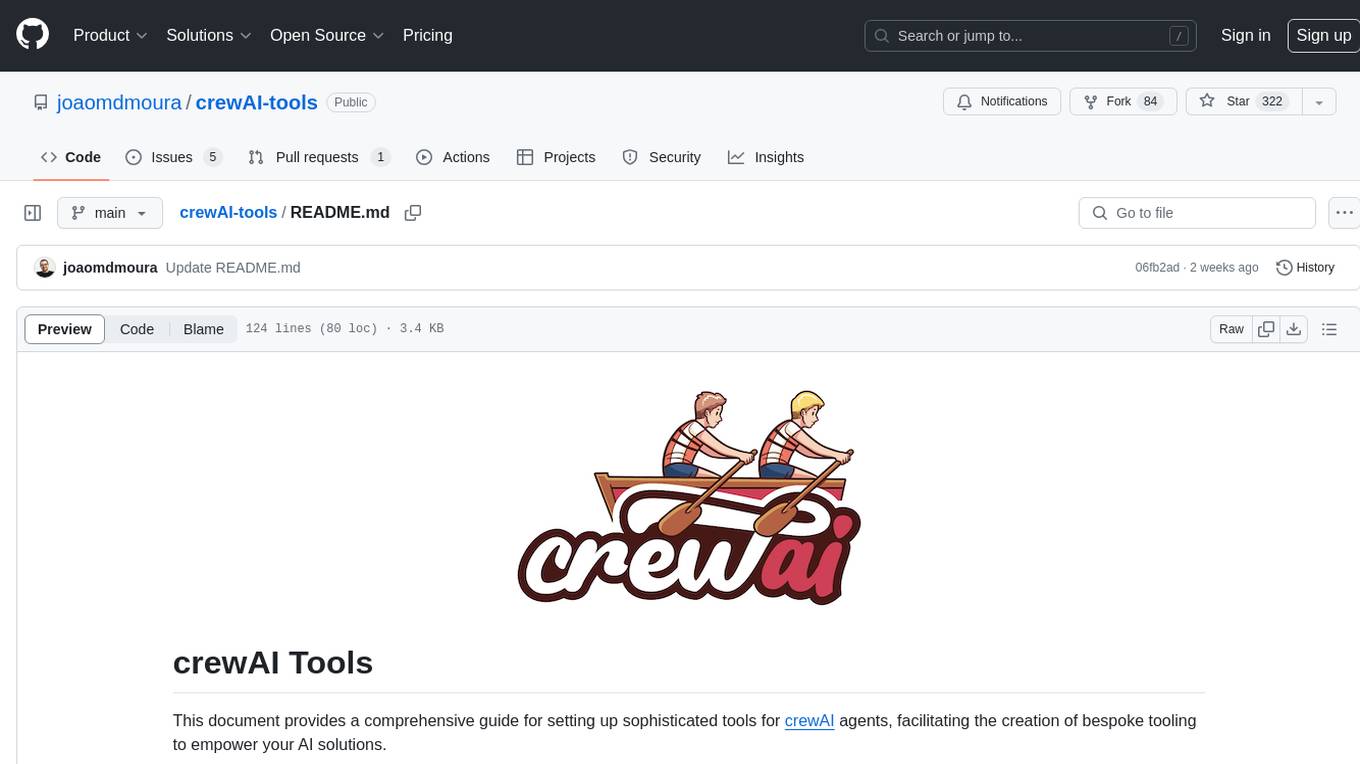
crewAI-tools
The crewAI Tools repository provides a guide for setting up tools for crewAI agents, enabling the creation of custom tools to enhance AI solutions. Tools play a crucial role in improving agent functionality. The guide explains how to equip agents with a range of tools and how to create new tools. Tools are designed to return strings for generating responses. There are two main methods for creating tools: subclassing BaseTool and using the tool decorator. Contributions to the toolset are encouraged, and the development setup includes steps for installing dependencies, activating the virtual environment, setting up pre-commit hooks, running tests, static type checking, packaging, and local installation. Enhance AI agent capabilities with advanced tooling.
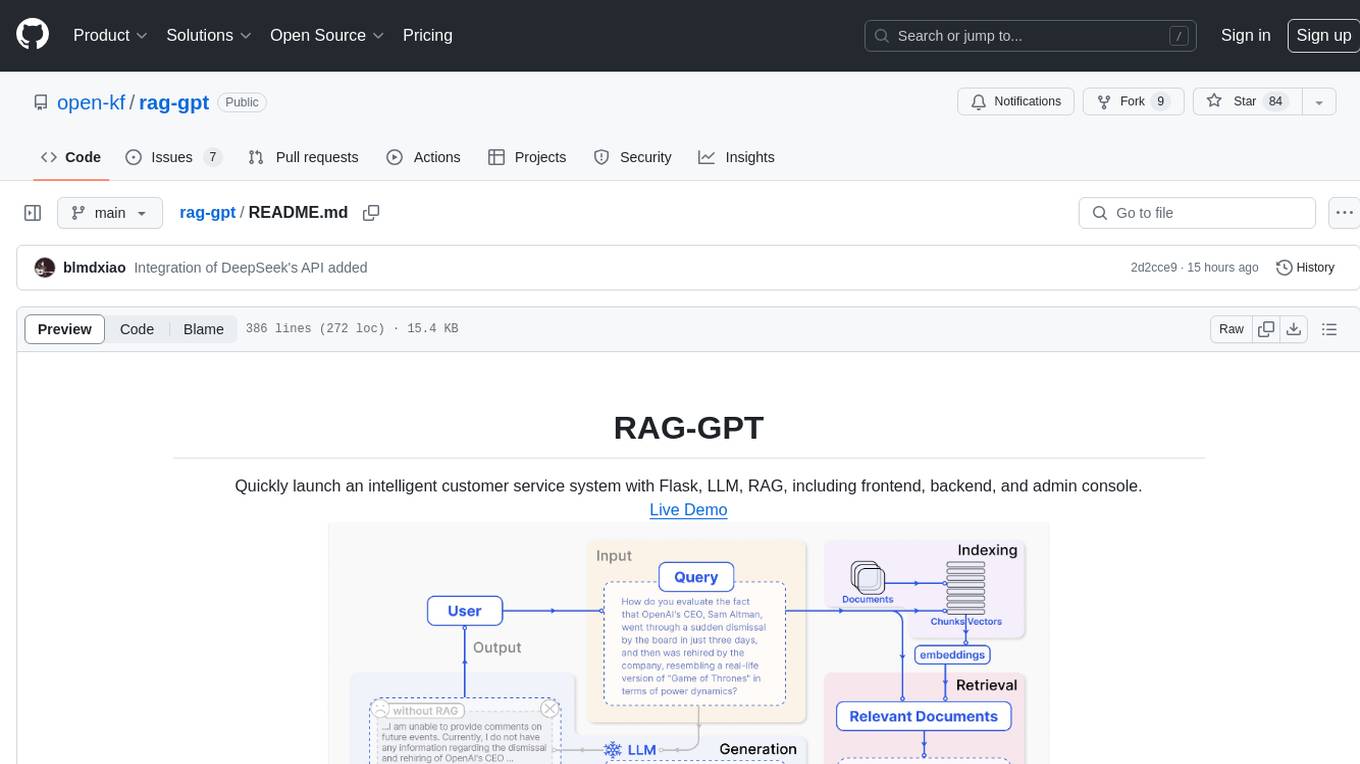
rag-gpt
RAG-GPT is a tool that allows users to quickly launch an intelligent customer service system with Flask, LLM, and RAG. It includes frontend, backend, and admin console components. The tool supports cloud-based and local LLMs, enables deployment of conversational service robots in minutes, integrates diverse knowledge bases, offers flexible configuration options, and features an attractive user interface.
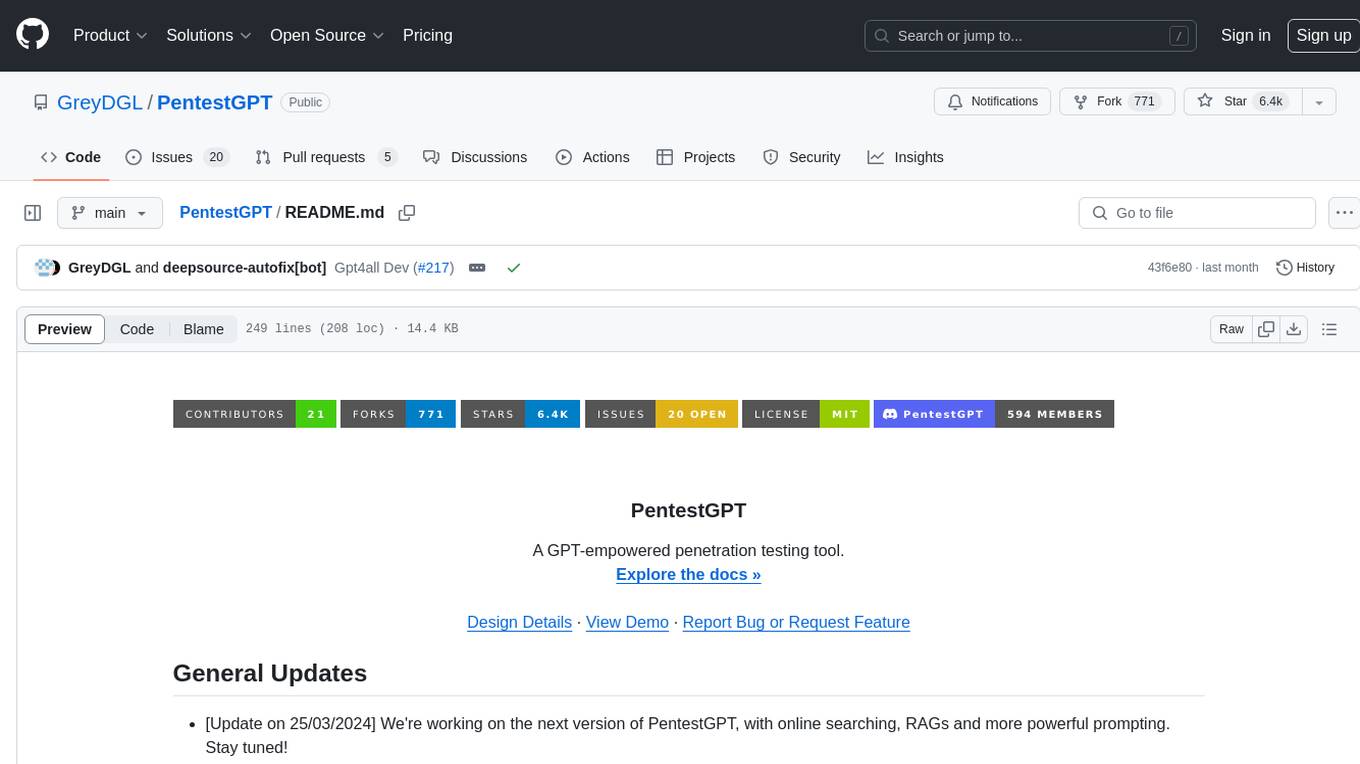
PentestGPT
PentestGPT is a penetration testing tool empowered by ChatGPT, designed to automate the penetration testing process. It operates interactively to guide penetration testers in overall progress and specific operations. The tool supports solving easy to medium HackTheBox machines and other CTF challenges. Users can use PentestGPT to perform tasks like testing connections, using different reasoning models, discussing with the tool, searching on Google, and generating reports. It also supports local LLMs with custom parsers for advanced users.
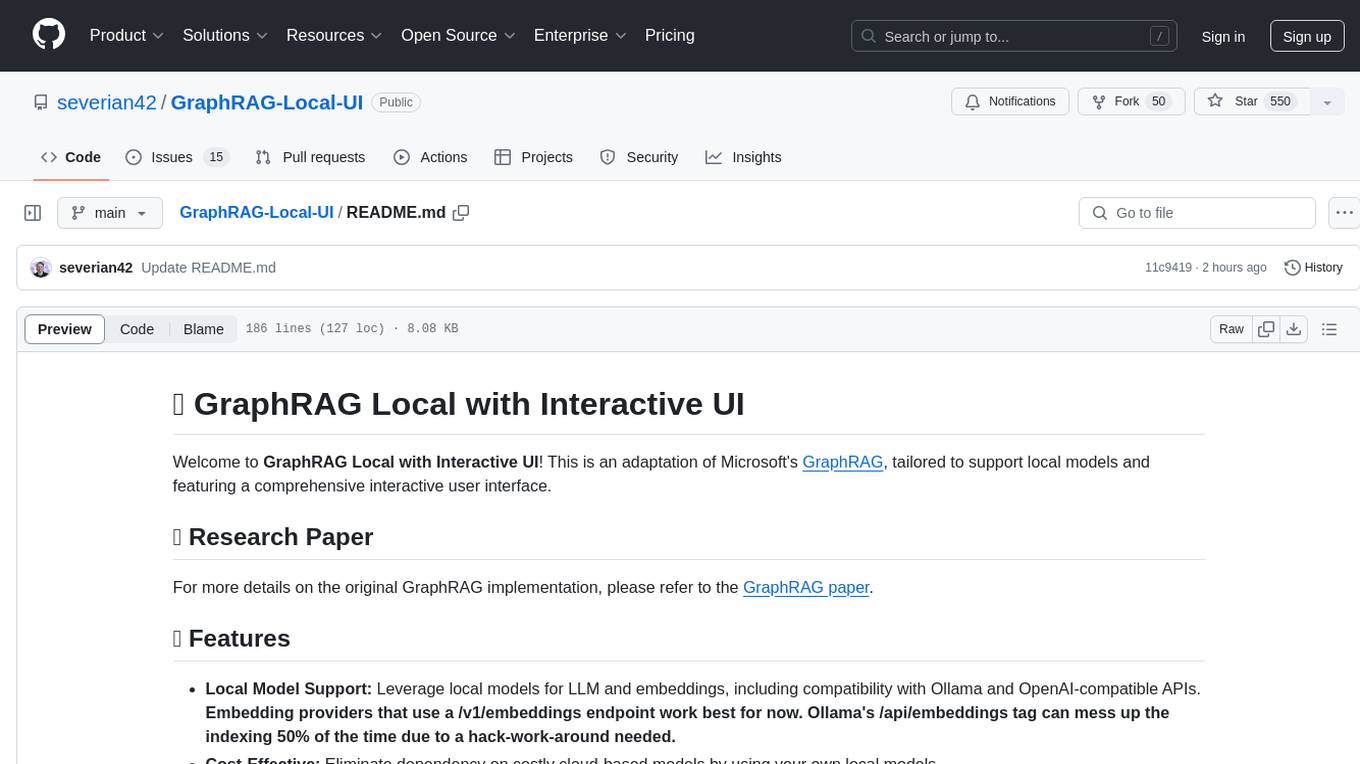
GraphRAG-Local-UI
GraphRAG Local with Interactive UI is an adaptation of Microsoft's GraphRAG, tailored to support local models and featuring a comprehensive interactive user interface. It allows users to leverage local models for LLM and embeddings, visualize knowledge graphs in 2D or 3D, manage files, settings, and queries, and explore indexing outputs. The tool aims to be cost-effective by eliminating dependency on costly cloud-based models and offers flexible querying options for global, local, and direct chat queries.

deepeval
DeepEval is a simple-to-use, open-source LLM evaluation framework specialized for unit testing LLM outputs. It incorporates various metrics such as G-Eval, hallucination, answer relevancy, RAGAS, etc., and runs locally on your machine for evaluation. It provides a wide range of ready-to-use evaluation metrics, allows for creating custom metrics, integrates with any CI/CD environment, and enables benchmarking LLMs on popular benchmarks. DeepEval is designed for evaluating RAG and fine-tuning applications, helping users optimize hyperparameters, prevent prompt drifting, and transition from OpenAI to hosting their own Llama2 with confidence.
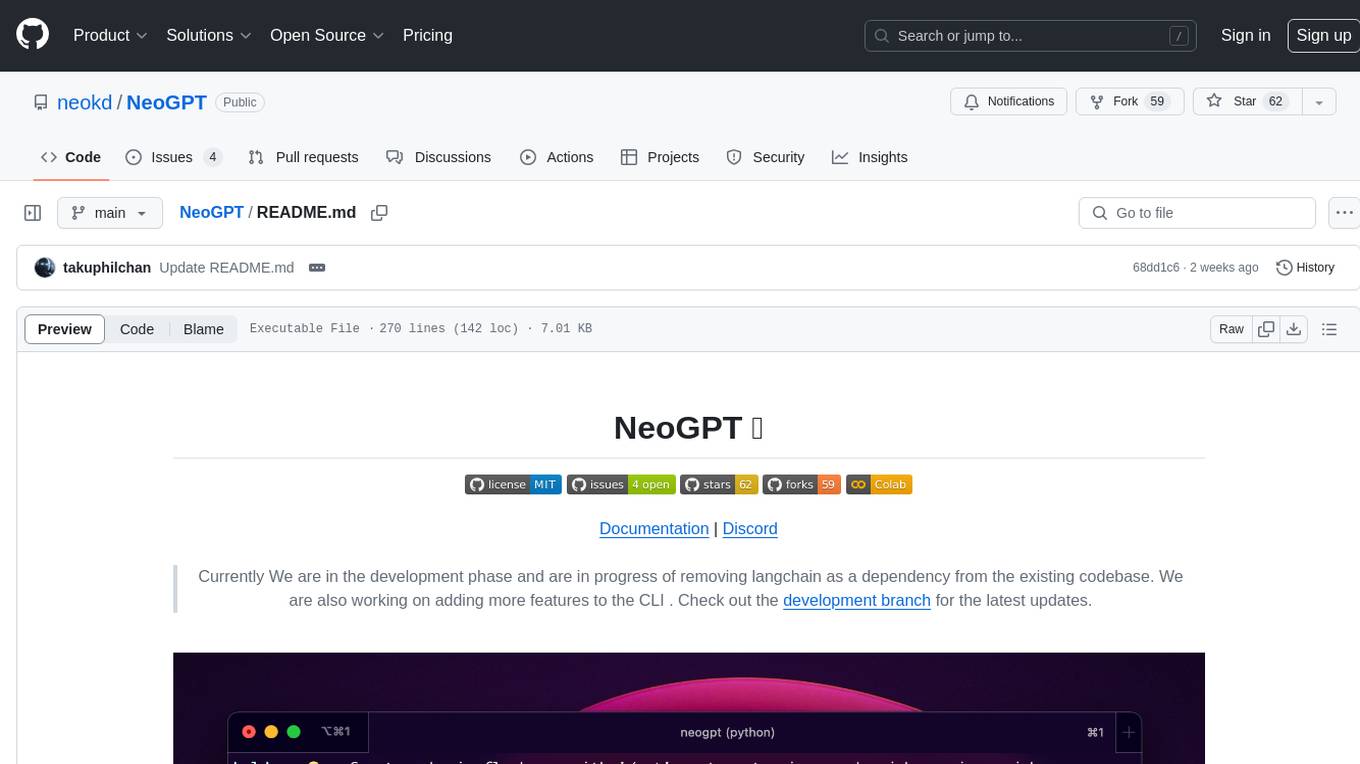
NeoGPT
NeoGPT is an AI assistant that transforms your local workspace into a powerhouse of productivity from your CLI. With features like code interpretation, multi-RAG support, vision models, and LLM integration, NeoGPT redefines how you work and create. It supports executing code seamlessly, multiple RAG techniques, vision models, and interacting with various language models. Users can run the CLI to start using NeoGPT and access features like Code Interpreter, building vector database, running Streamlit UI, and changing LLM models. The tool also offers magic commands for chat sessions, such as resetting chat history, saving conversations, exporting settings, and more. Join the NeoGPT community to experience a new era of efficiency and contribute to its evolution.
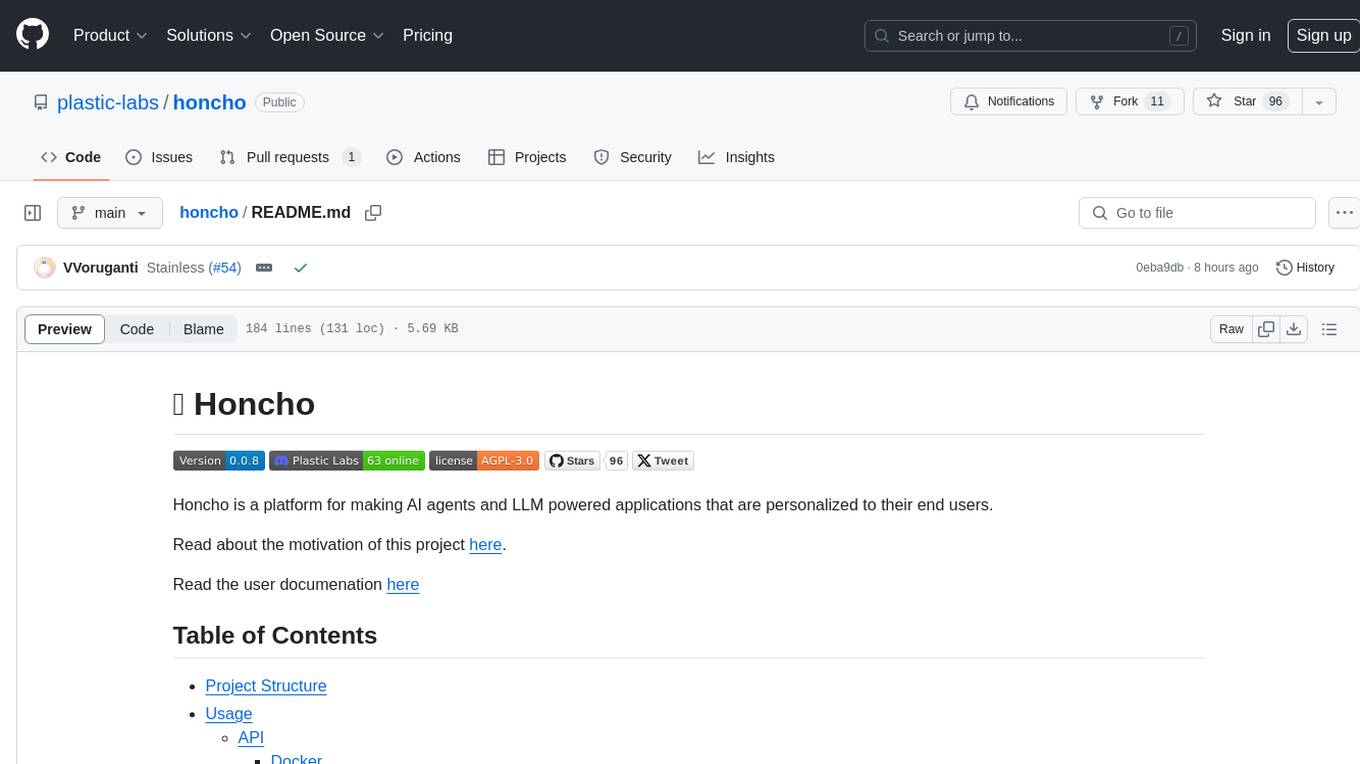
honcho
Honcho is a platform for creating personalized AI agents and LLM powered applications for end users. The repository is a monorepo containing the server/API for managing database interactions and storing application state, along with a Python SDK. It utilizes FastAPI for user context management and Poetry for dependency management. The API can be run using Docker or manually by setting environment variables. The client SDK can be installed using pip or Poetry. The project is open source and welcomes contributions, following a fork and PR workflow. Honcho is licensed under the AGPL-3.0 License.
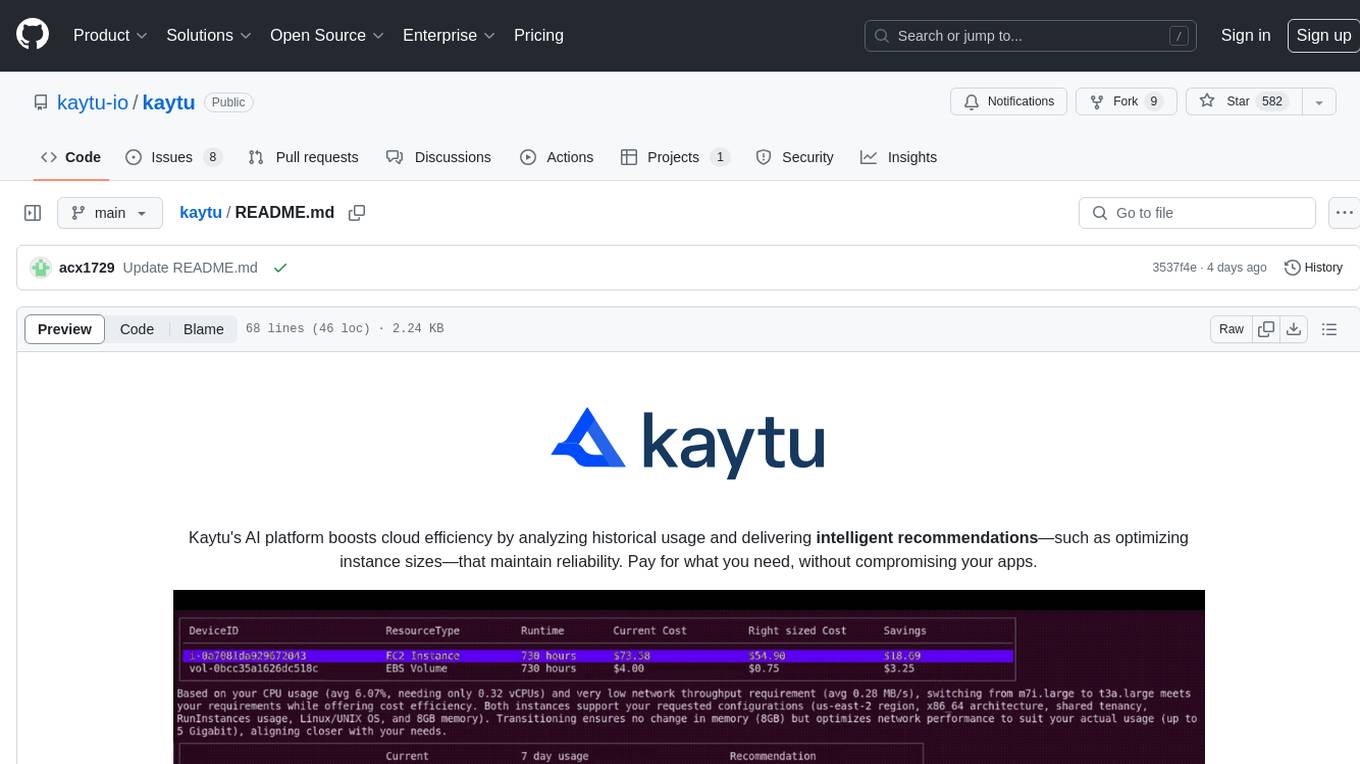
kaytu
Kaytu is an AI platform that enhances cloud efficiency by analyzing historical usage data and providing intelligent recommendations for optimizing instance sizes. Users can pay for only what they need without compromising the performance of their applications. The platform is easy to use with a one-line command, allows customization for specific requirements, and ensures security by extracting metrics from the client side. Kaytu is open-source and supports AWS services, with plans to expand to GCP, Azure, GPU optimization, and observability data from Prometheus in the future.
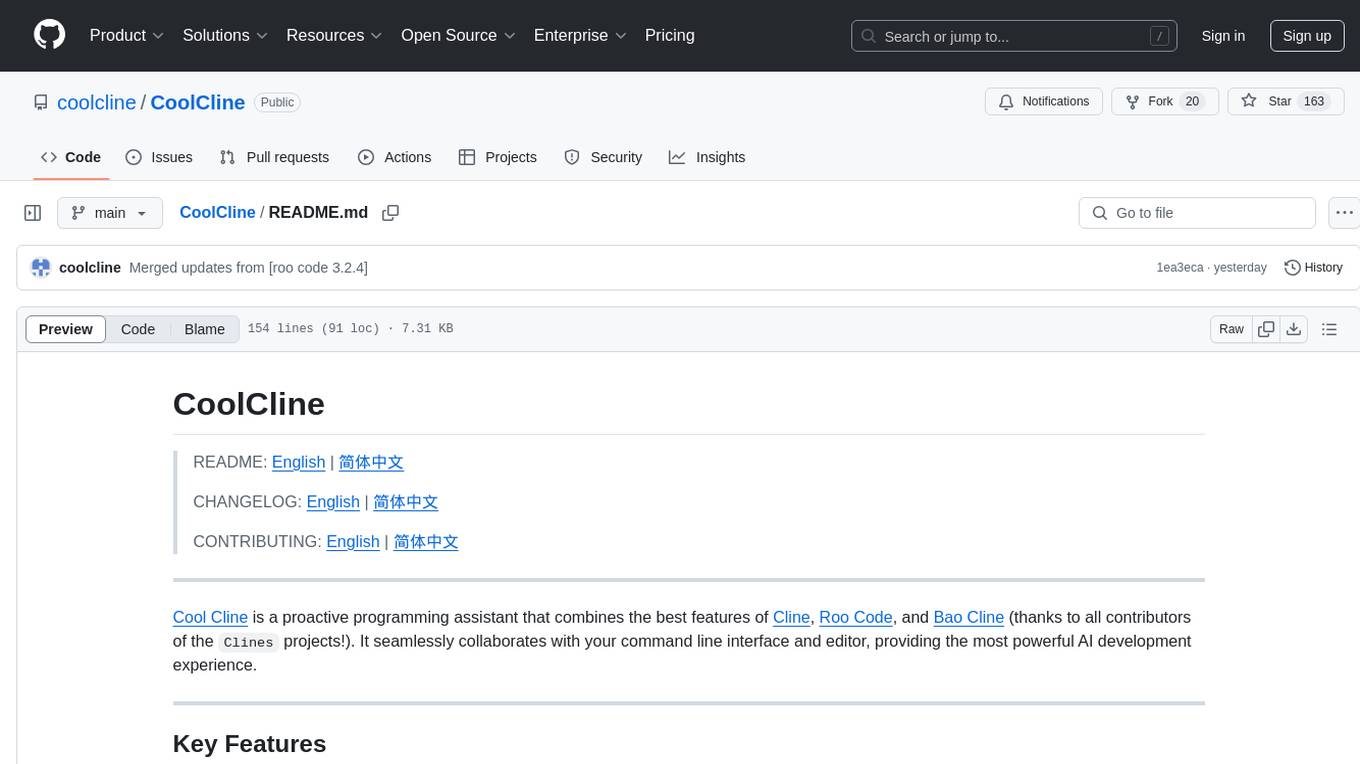
CoolCline
CoolCline is a proactive programming assistant that combines the best features of Cline, Roo Code, and Bao Cline. It seamlessly collaborates with your command line interface and editor, providing the most powerful AI development experience. It optimizes queries, allows quick switching of LLM Providers, and offers auto-approve options for actions. Users can configure LLM Providers, select different chat modes, perform file and editor operations, integrate with the command line, automate browser tasks, and extend capabilities through the Model Context Protocol (MCP). Context mentions help provide explicit context, and installation is easy through the editor's extension panel or by dragging and dropping the `.vsix` file. Local setup and development instructions are available for contributors.
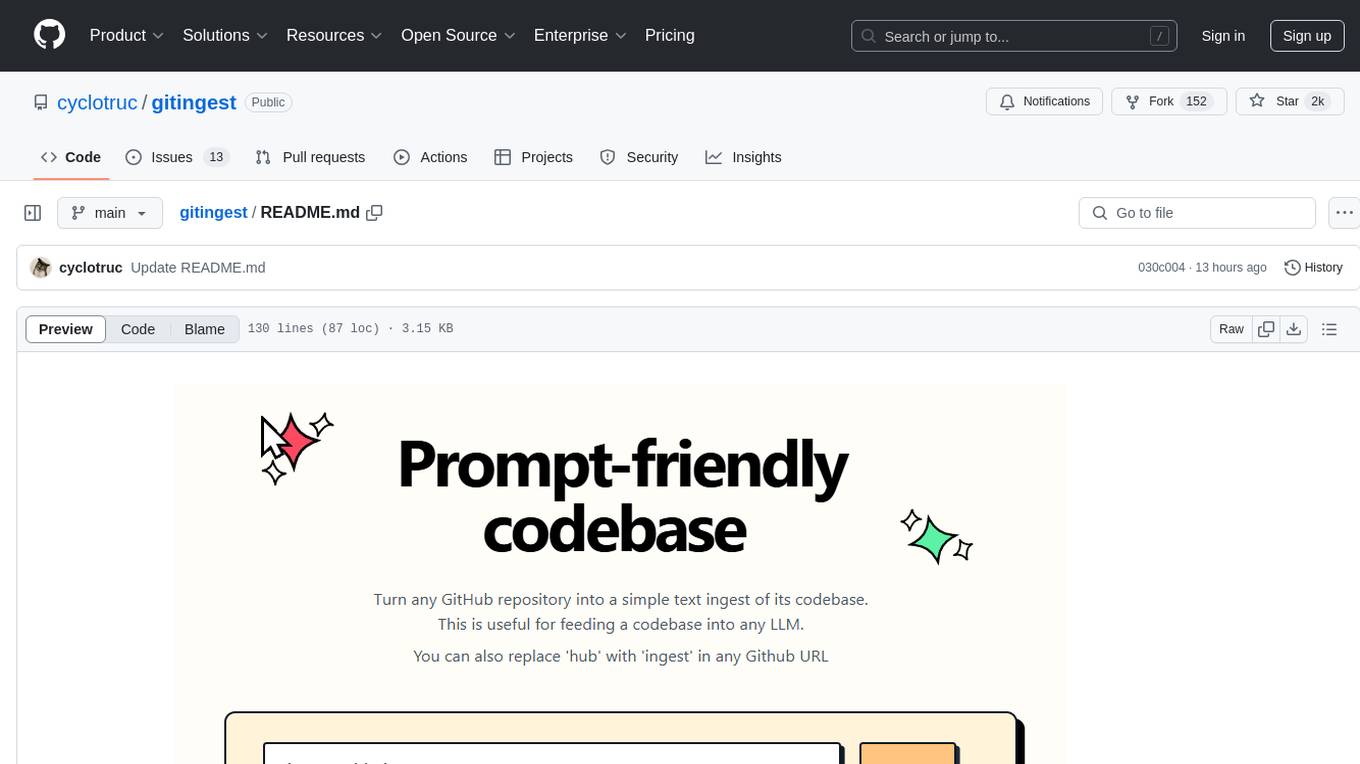
gitingest
GitIngest is a tool that allows users to turn any Git repository into a prompt-friendly text ingest for LLMs. It provides easy code context by generating a text digest from a git repository URL or directory. The tool offers smart formatting for optimized output format for LLM prompts and provides statistics about file and directory structure, size of the extract, and token count. GitIngest can be used as a CLI tool on Linux and as a Python package for code integration. The tool is built using Tailwind CSS for frontend, FastAPI for backend framework, tiktoken for token estimation, and apianalytics.dev for simple analytics. Users can self-host GitIngest by building the Docker image and running the container. Contributions to the project are welcome, and the tool aims to be beginner-friendly for first-time contributors with a simple Python and HTML codebase.
For similar tasks
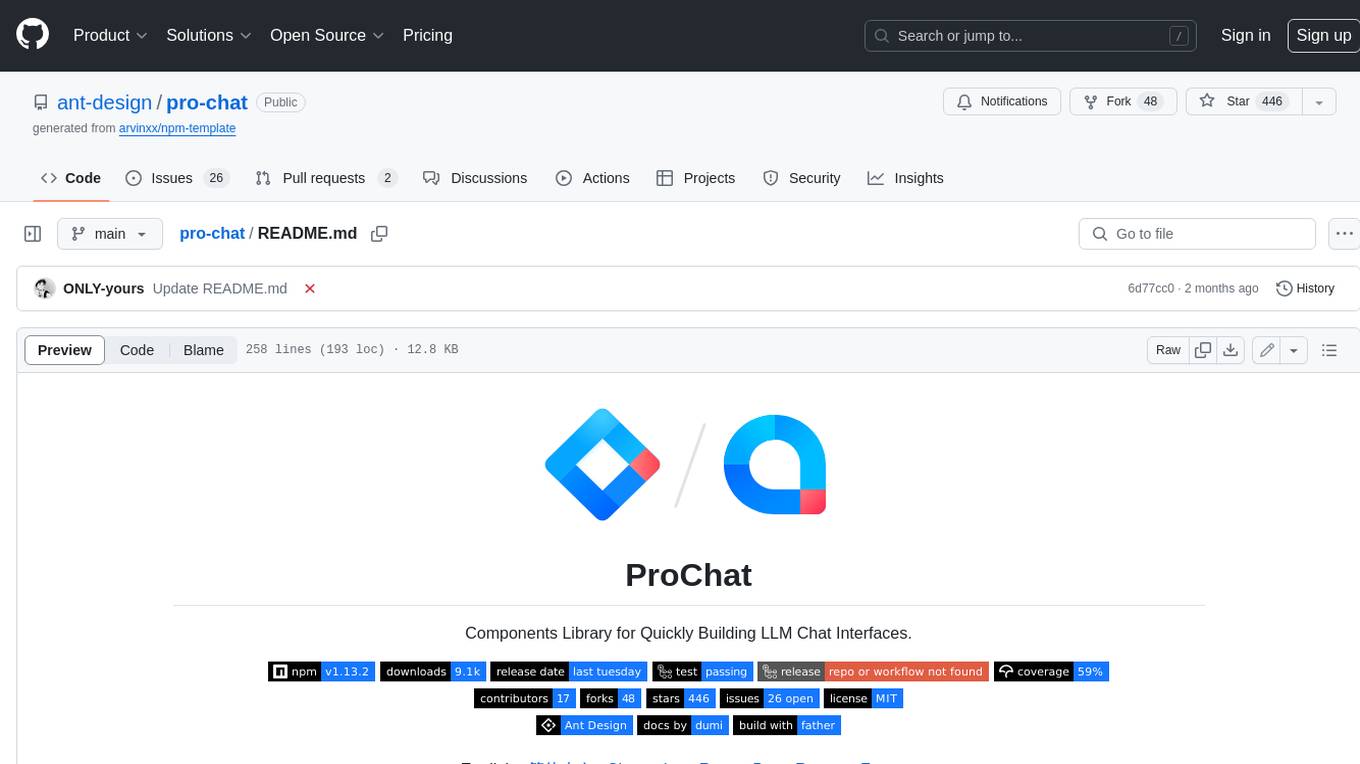
pro-chat
ProChat is a components library focused on quickly building large language model chat interfaces. It empowers developers to create rich, dynamic, and intuitive chat interfaces with features like automatic chat caching, streamlined conversations, message editing tools, auto-rendered Markdown, and programmatic controls. The tool also includes design evolution plans such as customized dialogue rendering, enhanced request parameters, personalized error handling, expanded documentation, and atomic component design.

nlux
NLUX is an open-source JavaScript and React JS library that simplifies the integration of powerful large language models (LLMs) like ChatGPT into web apps or websites. With just a few lines of code, users can add conversational AI capabilities and interact with their favorite LLM. The library offers features such as building AI chat interfaces in minutes, React components and hooks for easy integration, LLM adapters for various APIs, customizable assistant and user personas, streaming LLM output, custom renderers, high customizability, and zero dependencies. NLUX is designed with principles of intuitiveness, performance, accessibility, and developer experience in mind. The mission of NLUX is to enable developers to build outstanding LLM front-ends and applications with a focus on performance and usability.
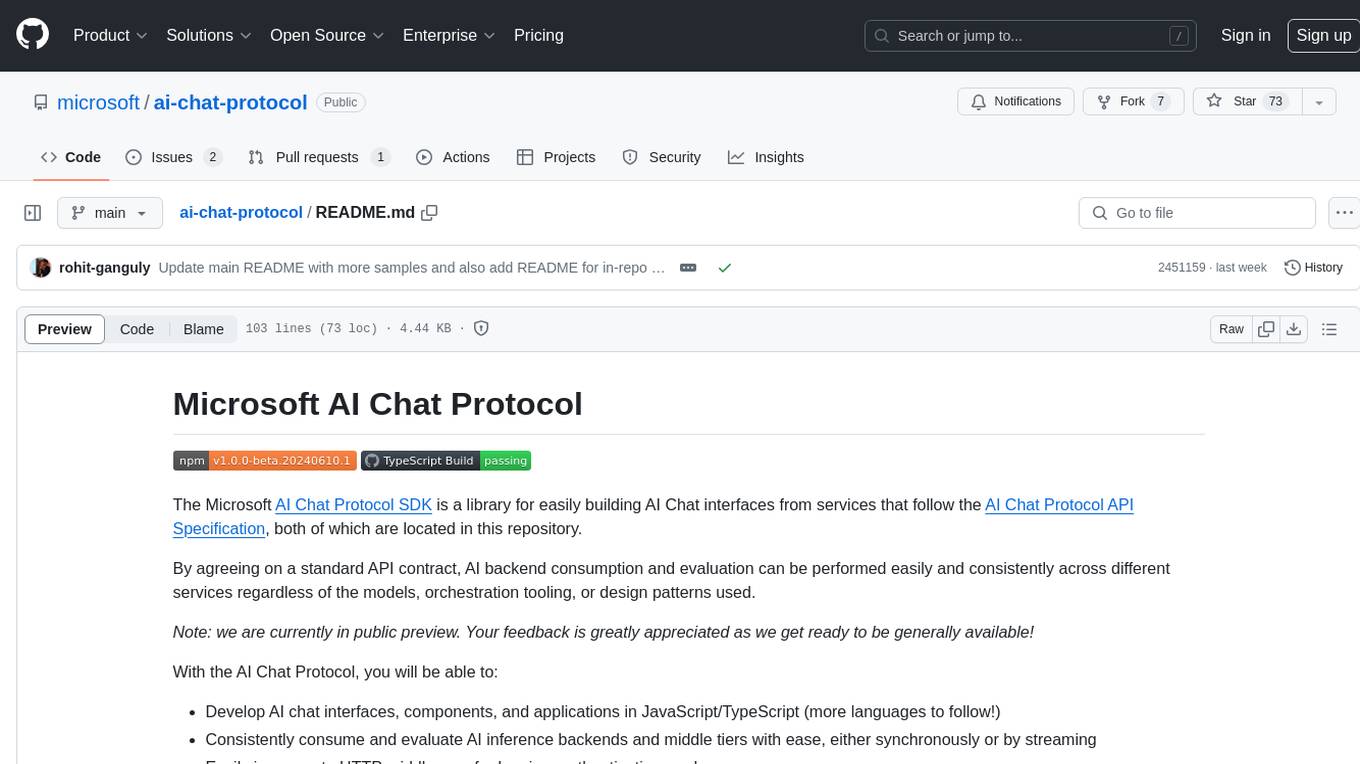
ai-chat-protocol
The Microsoft AI Chat Protocol SDK is a library for easily building AI Chat interfaces from services that follow the AI Chat Protocol API Specification. By agreeing on a standard API contract, AI backend consumption and evaluation can be performed easily and consistently across different services. It allows developers to develop AI chat interfaces, consume and evaluate AI inference backends, and incorporate HTTP middleware for logging and authentication.
For similar jobs

sweep
Sweep is an AI junior developer that turns bugs and feature requests into code changes. It automatically handles developer experience improvements like adding type hints and improving test coverage.

teams-ai
The Teams AI Library is a software development kit (SDK) that helps developers create bots that can interact with Teams and Microsoft 365 applications. It is built on top of the Bot Framework SDK and simplifies the process of developing bots that interact with Teams' artificial intelligence capabilities. The SDK is available for JavaScript/TypeScript, .NET, and Python.

ai-guide
This guide is dedicated to Large Language Models (LLMs) that you can run on your home computer. It assumes your PC is a lower-end, non-gaming setup.

classifai
Supercharge WordPress Content Workflows and Engagement with Artificial Intelligence. Tap into leading cloud-based services like OpenAI, Microsoft Azure AI, Google Gemini and IBM Watson to augment your WordPress-powered websites. Publish content faster while improving SEO performance and increasing audience engagement. ClassifAI integrates Artificial Intelligence and Machine Learning technologies to lighten your workload and eliminate tedious tasks, giving you more time to create original content that matters.

chatbot-ui
Chatbot UI is an open-source AI chat app that allows users to create and deploy their own AI chatbots. It is easy to use and can be customized to fit any need. Chatbot UI is perfect for businesses, developers, and anyone who wants to create a chatbot.

BricksLLM
BricksLLM is a cloud native AI gateway written in Go. Currently, it provides native support for OpenAI, Anthropic, Azure OpenAI and vLLM. BricksLLM aims to provide enterprise level infrastructure that can power any LLM production use cases. Here are some use cases for BricksLLM: * Set LLM usage limits for users on different pricing tiers * Track LLM usage on a per user and per organization basis * Block or redact requests containing PIIs * Improve LLM reliability with failovers, retries and caching * Distribute API keys with rate limits and cost limits for internal development/production use cases * Distribute API keys with rate limits and cost limits for students

uAgents
uAgents is a Python library developed by Fetch.ai that allows for the creation of autonomous AI agents. These agents can perform various tasks on a schedule or take action on various events. uAgents are easy to create and manage, and they are connected to a fast-growing network of other uAgents. They are also secure, with cryptographically secured messages and wallets.

griptape
Griptape is a modular Python framework for building AI-powered applications that securely connect to your enterprise data and APIs. It offers developers the ability to maintain control and flexibility at every step. Griptape's core components include Structures (Agents, Pipelines, and Workflows), Tasks, Tools, Memory (Conversation Memory, Task Memory, and Meta Memory), Drivers (Prompt and Embedding Drivers, Vector Store Drivers, Image Generation Drivers, Image Query Drivers, SQL Drivers, Web Scraper Drivers, and Conversation Memory Drivers), Engines (Query Engines, Extraction Engines, Summary Engines, Image Generation Engines, and Image Query Engines), and additional components (Rulesets, Loaders, Artifacts, Chunkers, and Tokenizers). Griptape enables developers to create AI-powered applications with ease and efficiency.




